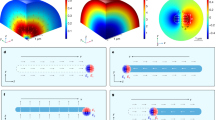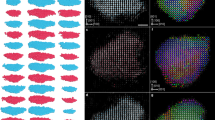Abstract
Ferroelectric topological textures in oxides exhibit exotic dipole-moment configurations that would be ideal for nonlinear spatial light field manipulation. However, conventional ferroelectric polar topologies are spatially confined to the nanoscale, resulting in a substantial size mismatch with laser modes. Here we report a dome-shaped ferroelectric topology with micrometre-scale lateral dimensions using nanometre-thick freestanding BaTiO3 membranes and demonstrate its feasibility for spatial light field manipulation. The dome-shaped topology results from a radial flexoelectric field created through anisotropic lattice distortion, which, in turn, generates centre-convergent microdomains. The interaction between the continuous curling of dipoles and light promotes the conversion of circularly polarized waves into vortex light fields through nonlinear spin-to-orbit angular momentum conversion. Further dynamic manipulation of vortex light fields can also be achieved by thermal and electrical switching of the polar topology. Our work highlights the potential for other ferroelectric polar topologies in light field manipulation.
This is a preview of subscription content, access via your institution
Access options
Access Nature and 54 other Nature Portfolio journals
Get Nature+, our best-value online-access subscription
27,99 € / 30 days
cancel any time
Subscribe to this journal
Receive 12 print issues and online access
269,00 € per year
only 22,42 € per issue
Buy this article
- Purchase on SpringerLink
- Instant access to full article PDF
Prices may be subject to local taxes which are calculated during checkout





Similar content being viewed by others
Data availability
The data that support the plots within this article and other findings of this study are available from the corresponding authors upon reasonable request.
References
Jia, C.-L., Urban, K. W., Alexe, M., Hesse, D. & Vrejoiu, I. Direct observation of continuous electric dipole rotation in flux-closure domains in ferroelectric Pb(Zr,Ti)O3. Science 331, 1420–1423 (2011).
Ivry, Y., Chu, D. P., Scott, J. F. & Durkan, C. Flux closure vortexlike ___domain structures in ferroelectric thin films. Phys. Rev. Lett. 104, 207602 (2010).
Tang, Y. L. et al. Observation of a periodic array of flux-closure quadrants in strained ferroelectric PbTiO3 films. Science 348, 547–551 (2015).
Yadav, A. K. et al. Observation of polar vortices in oxide superlattices. Nature 530, 198–201 (2016).
Nahas, Y. et al. Inverse transition of labyrinthine ___domain patterns in ferroelectric thin films. Nature 577, 47–51 (2020).
Das, S. et al. Observation of room-temperature polar skyrmions. Nature 568, 368–372 (2019).
Seidel, J. et al. Conduction at ___domain walls in oxide multiferroics. Nat. Mater. 8, 229–234 (2009).
Zubko, P. et al. Negative capacitance in multidomain ferroelectric superlattices. Nature 534, 524–528 (2016).
Guo, M. et al. Toroidal polar topology in strained ferroelectric polymer. Science 371, 1050–1056 (2021).
Wang, Y. J. et al. Polar meron lattice in strained oxide ferroelectrics. Nat. Mater. 19, 881–886 (2020).
Sánchez-Santolino, G. et al. A 2D ferroelectric vortex pattern in twisted BaTiO3 freestanding layers. Nature 626, 529–534 (2024).
Li, Q. et al. Subterahertz collective dynamics of polar vortices. Nature 592, 376–380 (2021).
Shafer, P. et al. Emergent chirality in the electric polarization texture of titanate superlattices. Proc. Nat. Acad. Sci. USA 115, 915–920 (2018).
Behera, P. et al. Electric field control of chirality. Sci. Adv. 8, eabj8030 (2022).
Han, H. et al. Electric field-manipulated optical chirality in ferroelectric vortex domains. Adv. Mater. 36, e2408400 (2024).
Yadav, A. K. et al. Spatially resolved steady-state negative capacitance. Nature 565, 468–471 (2019).
Jiang, J. et al. Temporary formation of highly conducting ___domain walls for non-destructive read-out of ferroelectric ___domain-wall resistance switching memories. Nat. Mater. 17, 49–56 (2018).
Rojac, T. et al. Domain-wall conduction in ferroelectric BiFeO3 controlled by accumulation of charged defects. Nat. Mater. 16, 322–327 (2017).
Junquera, J. et al. Topological phases in polar oxide nanostructures. Rev. Mod. Phys. 95, 025001 (2023).
Yu, N. et al. Light propagation with phase discontinuities: generalized laws of reflection and refraction. Science 334, 333–337 (2011).
Jisha, C. P., Nolte, S. & Alberucci, A. Geometric phase in optics: from wavefront manipulation to waveguiding. Laser Photonics Rev. https://doi.org/10.1002/lpor.202100003 (2021).
Jin, H. et al. On-chip generation and manipulation of entangled photons based on reconfigurable lithium-niobate waveguide circuits. Phys. Rev. Lett. 113, 103601 (2014).
Wang, J. et al. High-Q lithium niobate microdisk resonators on a chip for efficient electro-optic modulation. Opt. Express 23, 23072–23078 (2015).
Zhu, S., Zhu, Y. & Ming, N. Quasi-phase-matched third-harmonic generation in a quasi-periodic optical superlattice. Science 278, 843–846 (1997).
Xu, X. et al. Femtosecond laser writing of lithium niobate ferroelectric nanodomains. Nature 609, 496–501 (2022).
Liu, Y. et al. Broadband spin and orbital momentum modulator using self-assembled nanostructures. Adv. Mater. 36, 2412007 (2024).
Ni, J. C. et al. Multidimensional phase singularities in nanophotonics. Science 374, eabj0039 (2021).
Allen, L., Beijersbergen, M. W., Spreeuw, R. J. C. & Woerdman, J. P. Orbital angular momentum of light and the transformation of Laguerre–Gaussian laser modes. Phys. Rev. A 45, 8185–8189 (1992).
Wang, X. et al. Recent advances on optical vortex generation. Nanophotonics 7, 1533–1556 (2018).
Bai, Y., Lv, H., Fu, X. & Yang, Y. Vortex beam: generation and detection of orbital angular momentum. Chin. Opt. Lett. 20, 012601 (2022).
Yao, J. et al. Generation of optical vortices by diffraction from circular apertures. ACS Photonics 10, 4267–4272 (2023).
Wang, J. et al. Terabit free-space data transmission employing orbital angular momentum multiplexing. Nat. Photonics 6, 488–496 (2012).
Wang, J. Advances in communications using optical vortices. Photonics Res. 4, B14–B28 (2016).
Fang, X., Ren, H. & Gu, M. Orbital angular momentum holography for high-security encryption. Nat. Photonics 14, 102–108 (2019).
Tan, C. et al. Engineering polar vortex from topologically trivial ___domain architecture. Nat. Commun. 12, 4620 (2021).
Govinden, V. et al. Ferroelectric solitons crafted in epitaxial bismuth ferrite superlattices. Nat. Commun. 14, 4178 (2023).
Dong, G. et al. Super-elastic ferroelectric single-crystal membrane with continuous electric dipole rotation. Science 366, 475–479 (2019).
Sun, H. Y. et al. Nonvolatile ferroelectric ___domain wall memory integrated on silicon. Nat. Commun. 13, 4332 (2022).
Ji, D. X. et al. Freestanding crystalline oxide perovskites down to the monolayer limit. Nature 570, 87–90 (2019).
Hong, S. S. et al. Extreme tensile strain states in La0.7Ca0.3MnO3 membranes. Science 368, 71–76 (2020).
Han, L. et al. High-density switchable skyrmion-like polar nanodomains integrated on silicon. Nature 603, 63–67 (2022).
Xiao, J. et al. Intrinsic two-dimensional ferroelectricity with dipole locking. Phys. Rev. Lett. 120, 227601 (2018).
Pugachev, A. M. et al. Broken local symmetry in paraelectric BaTiO3 proved by second harmonic generation. Phys. Rev. Lett. 108, 247601 (2012).
Denev, S. A., Lummen, T. T. A., Barnes, E., Kumar, A. & Gopalan, V. Probing ferroelectrics using optical second harmonic generation. J. Am. Ceram. Soc. 94, 2699–2727 (2011).
Cherifi-Hertel, S. et al. Non-Ising and chiral ferroelectric ___domain walls revealed by nonlinear optical microscopy. Nat. Commun. 8, 15768 (2017).
Devlin, R. C., Ambrosio, A., Rubin, N. A., Mueller, J. P. B. & Capasso, F. Arbitrary spin-to-orbital angular momentum conversion of light. Science 358, 896–901 (2017).
Bliokh, K. Y., Rodriguez-Fortuno, F. J., Nori, F. & Zayats, A. V. Spin–orbit interactions of light. Nat. Photonics 9, 796–808 (2015).
Liu, G. et al. in Fundamentals and Applications of Nonlinear Nanophotonics (ed. Panoiu N. C.) 393–440 (Elsevier, 2024).
Li, G. et al. Continuous control of the nonlinearity phase for harmonic generations. Nat. Mater. 14, 607–612 (2015).
Guo, C. Q. et al. Domain evolution in bended freestanding BaTiO3 ultrathin films: a phase-field simulation. Appl. Phys. Lett. 116, 152903 (2020).
Balke, N. et al. Deterministic control of ferroelastic switching in multiferroic materials. Nat. Nanotechnol. 4, 868–875 (2009).
Matzen, S. et al. Super switching and control of in-plane ferroelectric nanodomains in strained thin films. Nat. Commun. 5, 4415 (2014).
Tate, M. W. et al. High dynamic range pixel array detector for scanning transmission electron microscopy. Microsc. Microanal. 22, 237–249 (2016).
Li, G., Zhang, S. & Zentgraf, T. Nonlinear photonic metasurfaces. Nat. Rev. Mater. 2, 17010 (2017).
Goodman, J. W. Introduction to Fourier Optics 3rd edn (Roberts & Company, 2005).
Sroor, H. et al. High-purity orbital angular momentum states from a visible metasurface laser. Nat. Photonics 14, 498–503 (2020).
Acknowledgements
We thank S. Wu and L. Gu for fruitful discussions. This work was supported by the National Natural Science Foundation of China (grant nos. 12434002, 12425410, 52372100 and U24A2011), the National Key R&D Program of China (grant nos. 2022YFA1402502, 2021YFA1400400 and 2019YFA0307900), the Natural Science Foundation of Jiangsu Province (grant nos. BK20240005 and BK20233001) and Fundamental Research Funds for the Central Universities (021314380269). H.S. acknowledges the China National Postdoctoral Program for Innovative Talents (grant no. BX20230152), the China Postdoctoral Science Foundation (grant no. 2024M751368) and the Natural Science Foundation of Jiangsu Province (grant no. BK20241189). W.S. acknowledges the National Natural Science Foundation of China (grant no. 123B2051). P.C. acknowledges the China National Postdoctoral Program for Innovative Talents (grant no. BX20240157), the Jiangsu Funding Program for Excellent Postdoctoral Talent (grant no. 2024ZB517), the China Postdoctoral Science Foundation (grant no. 2024M751366) and the Natural Science Foundation of Jiangsu Province (grant no. BK20241190).
Author information
Authors and Affiliations
Contributions
Y.N. and Y.Z. conceived and supervised the project. H.S. synthesized and analysed the crystalline structure of BTO–SAO–STO heterostructures with the help of Y.L., D.X., J.Y., S.Y., Z.M. and Z.W. under the supervision of Z.G., D.W. and Y.N. H.S. performed polarization characterizations and analysis with help from J.W., W.S., B.H., T.Z., Z.C., N.Z. and Y.G. P.C. conducted optical measurements and simulations under the supervision of Y.Z., with the help of J.M. W.M. conducted STEM measurements and analysis under the supervision of P.W. C.G. conducted the phase-field simulations under the supervision of H.H. Y.N. and H.S. wrote the paper. All authors discussed the data and contributed to the paper.
Corresponding authors
Ethics declarations
Competing interests
The authors declare no competing interests.
Peer review
Peer review information
Nature Nanotechnology thanks Yuanjie Yang and the other, anonymous, reviewer(s) for their contribution to the peer review of this work.
Additional information
Publisher’s note Springer Nature remains neutral with regard to jurisdictional claims in published maps and institutional affiliations.
Supplementary information
Supplementary Information
Supplementary Figs. 1–12 and Table 1.
Rights and permissions
Springer Nature or its licensor (e.g. a society or other partner) holds exclusive rights to this article under a publishing agreement with the author(s) or other rightsholder(s); author self-archiving of the accepted manuscript version of this article is solely governed by the terms of such publishing agreement and applicable law.
About this article
Cite this article
Sun, H., Chen, P., Mao, W. et al. Ferroelectric topologies in BaTiO3 nanomembranes for light field manipulation. Nat. Nanotechnol. (2025). https://doi.org/10.1038/s41565-025-01919-y
Received:
Accepted:
Published:
DOI: https://doi.org/10.1038/s41565-025-01919-y
This article is cited by
-
Twisted light with a designed polar topology
Nature Nanotechnology (2025)



